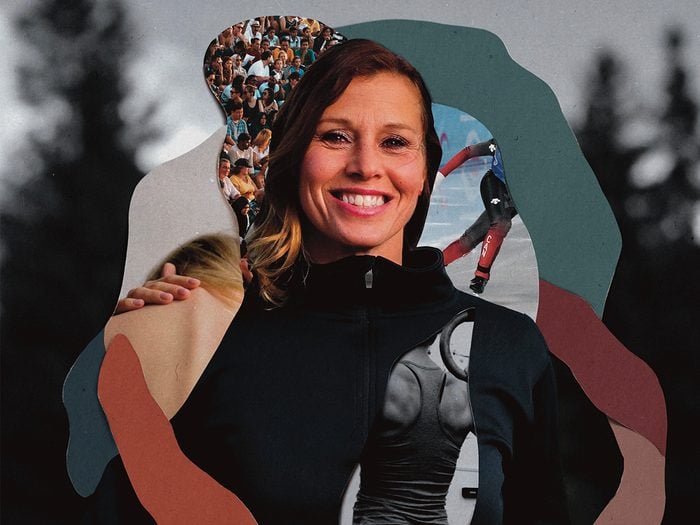Olympic Legend Catriona Le May Doan: “I Worried About How People Viewed Me My Whole Career”

Catriona Le May Doan shares this candid essay about her experience with body image issues in elite sports.
I used to joke that speedskaters are built like pears. We tend to have big butts, big legs and a small upper body. I think strong, muscular bodies are beautiful. But it’s hard not to feel self-conscious, especially if I think back to my peak training days leading up to the 1998 Olympics in Nagano and 2002 in Salt Lake City. Then you add the skin-tight suits and television cameras, and you look a lot bigger than you are.
During that time, if I wore a bikini in the summer, people would always stare because I had massive, super strong legs. Did I worry about how people looked at me? Pretty much my whole career. That’s part of the reason I started wearing the dark glasses—I loved that extra layer to hide behind. I wasn’t worried about how I looked—I celebrated whatever size I was through sports performance—but I was hiding from the opinions and pressure of all those watching me.
I’ve been retired for 18 years and people still ask if my legs are as “huge” as they were. I realized that’s the image people had. I’m nearly 51 and, naturally, my body has changed since I was an Olympian. I now understand how people get into a funk, not wanting to work out. When I was competing, I had so many people involved in my weight, body and health. Now it’s all up to me.
As a mother, I’m also more aware of the pressure on women athletes to look a certain way. When my daughter was around eight, she asked me, “Mom, are my legs going to be big?” I told her “Well, they might be like Mommy’s—and Mommy’s legs are pretty big.” My daughter is 17 now and a great ringette player. She will still make comments about her body. I try and remind her that being healthy and strong is the best look there is, but there’s more pressure now, especially with social media, which wasn’t around when I was competing. Being a woman and an athlete means that your body is held to two different standards that sometimes don’t align.
We’ve started to celebrate strong bodies, but not enough. We need to be having conversations with young girls, and boys as well, about preconceived notions about what an athletic body looks like. We need to build self-confidence in these young athletes, separate from the pressure to look a certain way.
It took me quite a few years of retirement to be more comfortable with, and more accepting of, my body. I’ve started playing “old lady” hockey and ringette, and going for runs. I’m super slow, and my teams are in the lowest division, but there isn’t the same end goal.
If I really wanted to look ripped, I could change what I eat and drink. But these days, I’m more focused on how I feel about myself. That’s really what’s changed: I’m not doing this for somebody else. I’m doing this for me.
This essay is part of Best Health’s Body Talk package exploring the issue of body image in elite sports. Read more about the experiences of current and former Winter Olympians and Paralympians, and what is being done to make sports a safer space for all athletes, here:
“Fat Doesn’t Fly”: Inside the Culture of Body Shaming in Figure Skating
Paralympian Brittany Hudak: “I Didn’t Think About Body Image Until I Became an Elite Athlete”
Bobsledder Cynthia Appiah: “I Looked Phenomenal, but I Felt Absolutely Terrible”
Alpine Skier Erin Mielzynski: “I Was Just Trying To Be Perfect”
Speed Skater Alyson Charles: “I Consider Myself Lucky”
Get more great stories delivered straight to your inbox by signing up for the Best Health Must-Reads newsletter. Subscribe here.




